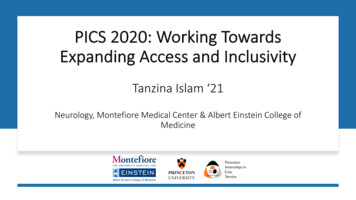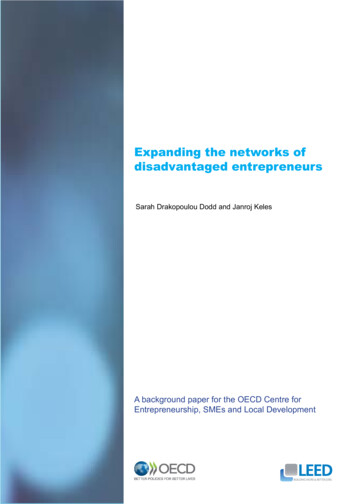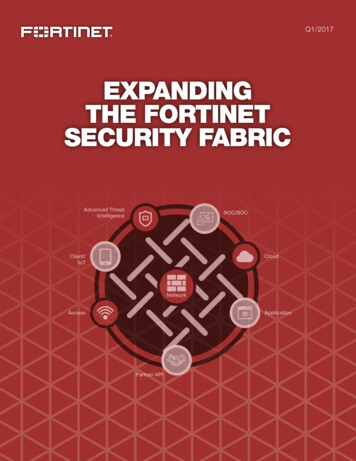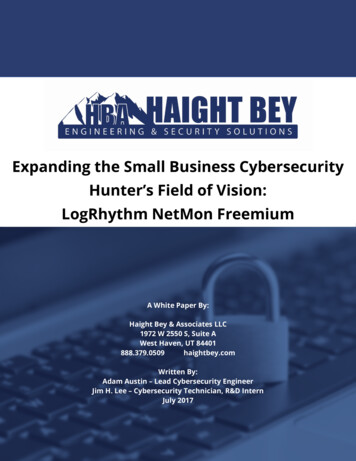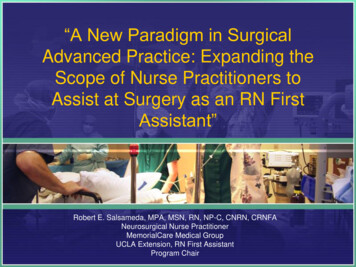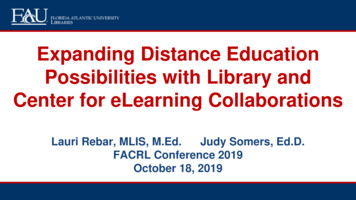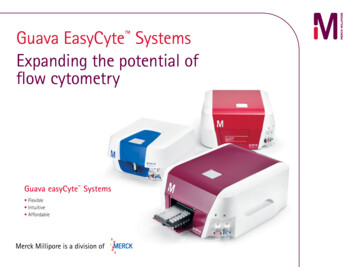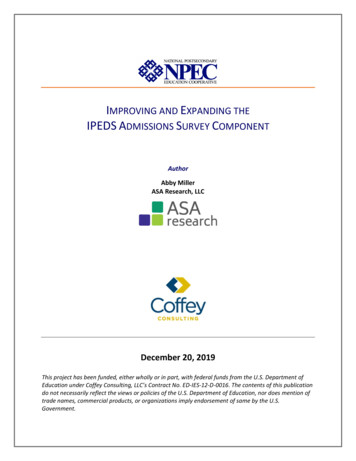
Transcription
IMPROVING AND EXPANDING THEIPEDS ADMISSIONS SURVEY COMPONENTAuthorAbby MillerASA Research, LLCDecember 20, 2019This project has been funded, either wholly or in part, with federal funds from the U.S. Department ofEducation under Coffey Consulting, LLC’s Contract No. ED-IES-12-D-0016. The contents of this publicationdo not necessarily reflect the views or policies of the U.S. Department of Education, nor does mention oftrade names, commercial products, or organizations imply endorsement of same by the U.S.Government.
National Postsecondary Education CooperativeThe National Postsecondary Education Cooperative (NPEC) was established by the NationalCenter for Education Statistics (NCES) in 1995 as a voluntary organization that encompasses allsectors of the postsecondary education community including federal agencies, postsecondaryinstitutions, associations, and other organizations with a major interest in postsecondaryeducation data collection. In 2007, NCES assigned NPEC the responsibility for developing aresearch and development agenda for the Integrated Postsecondary Education Data System(IPEDS), which is the core postsecondary education data collection program for NCES. NPEC alsooccasionally produces products of value to postsecondary data providers, users, and institutionalrepresentatives.NPEC publications do not undergo the formal review required for standard NCES products. Theinformation and opinions published in them are the products of NPEC and do not necessarilyrepresent the policy or views of the U.S. Department of Education or NCES.December 2019.The NCES Home Page address is http://nces.ed.govThe NCES Publications and Products address is http://nces.ed.gov/pubsearchThe NPEC Home Page address is https://nces.ed.gov/ipeds/join-in/npecThis publication is only available online. To download, view, and print the report as a PDF file,go to the NCES Publications and Products address shown above.Suggested CitationMiller, A. (2019). Improving and expanding the IPEDS Admissions survey component. (NPEC2019). U.S. Department of Education. Washington, DC: National Postsecondary EducationCooperative. Retrieved [date] from http://nces.ed.gov/pubsearch.NPEC MembersEric Atchison, Arkansas State University SystemEileen Brennan, Henry Ford CollegeBryan Cook, Association for Public and Land-Grant UniversitiesNancy Floyd, North Carolina State UniversityTanya I. Garcia, Georgetown University – Center on Education and the WorkforceLuke Gentala, Liberty UniversityThomas Harnisch, American Association of State Colleges and UniversitiesStephen Haworth, Adtalem Global EducationDarby Kaikkonen, Washington State Board for Community and Technical EducationSusan Lounsbury, Southern Regional Education BoardKent Phillippe, American Association of Community CollegesJason Ramirez, National Association of Independent Colleges and UniversitiesJonathan Turk, American Council on EducationContent Contact: Tara Lawley at (202) 245-7081 or Tara.Lawley@ed.gov
CONTENTSExecutive Summary . iiIntroduction . 1Methodology. 1History and Background . 2Environmental Scan . 3Interview Findings . 16Recommendations . 22Conclusions . 25References . 26i
EXECUTIVE SUMMARYThis paper sought to explore areas of potential improvement to the Integrated PostsecondaryEducation Data System (IPEDS) Admissions survey component (ADM) based on anenvironmental scan, data analyses, and interviews with stakeholders who use and report theADM data. NPEC commissioned this paper due to an interest in better representing growingstudent populations who are not currently included in ADM data.The environmental scan suggests a shift in recent years toward a more holistic admissionsprocess with less emphasis on standardized test scores. IPEDS ADM data show that nearly allinstitutions (90 percent) require students’ high school records for admission, while just overhalf (58 percent) require test scores. The largest difference in the test score requirement can befound by Carnegie classification, with 92 percent of Doctoral/Research universities, 80 percentof Master’s institutions, and 67 percent of Baccalaureate colleges requiring test scores.An external survey comparison between IPEDS ADM and three national admissions surveys wasconducted to identify potential areas for updating or adding to the scope of the current IPEDSADM survey questions. Two of the external surveys collect information about transfer students,while IPEDS ADM is limited to first-time students. The comparison found consistencies amongquestions related to academic considerations and requirements, with external surveys askingmore detailed questions about exam requirements. In addition, The IPEDS ADM is the onlysurvey not to include items reflecting non-academic considerations such as extracurricularactivities, alumni, and work experience.Interviewees—representing institutions, states, membership associations, and a collegerankings publication—generally find the IPEDS admissions data useful. While more detailedadmissions data are available through external surveys, data users rely on the IPEDS databecause it reflects a large and diverse set of institutions. However, IPEDS ADM is currentlylimited to information about first-time students, and all interviewees indicated that they wouldlike to see the collection expanded to include transfer students.Following the addition of transfer students, the most frequently cited suggestion frominterviewees is to expand considerations questions to non-academic areas to reflect a moreholistic admission process. Additional suggestions include expanding the survey to includegraduate students, open admission institutions, a 12-month data collection (as opposed to aFall enrollment snapshot), and items reflecting test-optional admissions, GPA, and earlyadmissions.While recognizing the potential associated challenges, interviewees are also interested in theaddition of items that would help assess equity in the admission process, such as financial need,financial aid offered, first-generation status, and alumni status. Finally, interviewees madesuggestions for additional information to collect regarding test scores and test score use.Based on information collected through the environmental scan, data analysis, and interviews,recommendations for further exploration include:ii
1. Include the means to collect data reflecting transfer students.2. Add items to gather non-academic considerations.3. Add a question about test-optional policies, or clarify current response options for testscore considerations.A future survey or TRP can investigate in further detail the other potential additions andchanges suggested by interviewees. It is important to include a mix of stakeholders in futurediscussions about changes to ADM, such as college admissions staff and administrators,institutional researchers, and consumers.iii
INTRODUCTIONThis paper explores the Integrated Postsecondary Education Data System (IPEDS) Admissions(ADM) survey component through a general overview of the current landscape of admissionsdata and provides recommendations to ensure that the ADM survey component provideshelpful information to both prospective students and their families (consumers) andresearchers interested in the college admissions process. The National Postsecondary EducationCooperative (NPEC) previously commissioned papers on the topics of transfer student data andgraduate student data. 1 Both papers recommended expanding the ADM survey component tocollect more information related to their respective student populations of interest. In responseto those recommendations, NPEC commissioned this paper focused solely on how the ADMsurvey component could be expanded to more accurately reflect the current admissionslandscape.This paper seeks to address the following research questions:1) What current higher education trends or populations are relevant to admissions data?Are they particular to a specific sector or all institutions?2) What admissions data are currently available through IPEDS?a. Are there other reliable sources collecting the data? If so, what are thelimitations in those other sources?b. How are the data used?3) What are the limitations with the current IPEDS admissions data collection in answeringquestions from various stakeholders?4) What data are needed to answer important questions related to admissions that IPEDScannot currently answer?a. Which data are needed in IPEDS Data Center or College Navigator?b. What are the challenges to collecting these data (i.e., data availability orincreased burden on reporting institutions)?5) How can the current IPEDS admissions data collection be improved through definitionsor instructions to better answer research questions and reflect the trends occurring inthe postsecondary landscape?METHODOLOGYThe research for this paper consisted of the following methods: A review of the most recent ADM survey questions and data elements currentlycollected by IPEDS; the origin and evolution of the ADM survey as profiled in The Historyand Origins of Survey Items for the Integrated Postsecondary Education Data SystemBoth papers are available at: ary-cooperative-educationnpec-products.11
report; 2 and a cross-comparison of IPEDS admissions questions and those included inthe Common Data Set (CDS), National Association for College Admission Counseling(NACAC) annual surveys, and the recent American Association of Collegiate Registrarsand Admissions Officers (AACRAO) survey. 3A high-level environmental scan of recent research related to admissions to ascertainwhat specific topics within admissions are of interest to researchers and consumers.Nine informational interviews with institutional stakeholders and additional interviewswith NCES staff (the number of non-NCES interviewees is limited to nine as seekingfederal clearance from the Office of Management and Budget [OMB] to interview morethan nine participants is beyond the scope of NPEC papers). Additionally, NPECmembers provided supplementary feedback via meetings. The nine intervieweesincluded:o Two community college representativeso Two public four-year institutionso One private four-year institutiono One state university system (previously board of trustees)o One membership association of public four-year institutionso One membership association of college admissions counselorso College rankings publicationHISTORY AND BACKGROUNDThe ADM component is a relatively new survey; until 2014-15, ADM questions were part of theInstitutional Characteristics (IC) component. The admissions questions were originally added tothe IC component in 2001-2002 (Aliyeva, Cody, & Low, 2018). The Higher EducationOpportunity Act of 2008 (HEOA) required the addition of admissions data to College Navigator.A 2004 Technical Review Panel (TRP) made the following recommendations about admissionsquestions: Either eliminate admissions considerations from the IC component or distinguish“between entrance requirements and those that are part of the application process.”The TRP discussed, but did not address, the concern about admission requirementsbeing program-specific.Specify that institutions report the number of students who applied, were admitted, andenrolled for the current year rather than allow institutions to select the time period.Allow institutions to report gender total if a breakout is not available (particularly forapplicants).Aliyeva, A., Cody, C.A., & Low, K. (2018). The History and Origins of Survey Items for the Integrated PostsecondaryEducation Data System (2016–17 Update). (NPEC 2018-023). U.S. Department of Education. Washington, D.C.:National Postsecondary Education Cooperative. Retrieved from http://nces.ed.gov/pubsearch3AACRAO recently released a report of findings from its first survey of admission practices, conducted jointly withNACAC. This survey “is meant to compliment both IPEDS and [NACAC State of College Admission survey] data.”22
Allow institutions to report test scores for any enrolled students who took the test(rather than limit reporting to institutions where a minimum of 60 percent of studentsprovided test scores).ENVIRONMENTAL SCANThe college admissions field has seen a shift in recent years toward a more holistic approachwith less emphasis on standardized test scores. A 2019 Chronicle of Higher Education report ontrends in higher education predicts that an increasing number of institutions will shift from testrequired to test optional (“Other Changes on the Horizon,” 2019). Over 200 colleges have deemphasized the ACT and SAT since 2005 including the University of Chicago, a highly-selectiveinstitution. As the Chronicle report notes, institutions are relying on more sophisticatedpredictive analytics which have shown that test scores may not be the best predictor of studentsuccess at an institution. In addition, some institutions and publications that produce rankingsare focusing more on social mobility as an indicator of institutional success. An Inside Higher Ed2018 Survey of College and University Admissions Directors also found that, in light of theUniversity of Chicago decision, respondents expect other institutions to follow suit (Jaschik,2018).The NACAC 2018 annual State of College Admission (SOCA) reported on changes to admissionpatterns between Fall 2016 and Fall 2017 based on its annual survey. The report showed anincrease in applications and a slight decrease in yield rate for first-time students. Transferstudents have a lower acceptance rate than first-time students but a much higher yield rate(Clinedinst & Patel, 2018). Other year-over-year trends included a slight increase in earlydecision and early action applications and an increase in wait list acceptances. Institutionsresponding to NACAC’s annual survey indicate that grades, standardized test scores, and highschool curriculum are the top factors for first-time students, while grades are the mostimportant consideration for transfers.Due to recent events and changes in how to identify college-readiness and academic ability,institutions are beginning to rethink the traditional admissions process. A recent scandalrelated to wealthy families “gaming” the admissions system through bribery and other meanshas garnered much national media attention. AACRAO developed a survey of admissionpractices jointly with NACAC in 2018, which includes a question about institutions’ admissiondecision rubrics, “in response to the recent and ongoing news about the various admissionscandals” (AACRAO, 2019). The survey found that the majority (68 percent) of respondinginstitutions consider at least one factor such as an academic index. Private, not-for-profitinstitutions are the most likely to consider other factors, including legacy applicants andapplicants “who have completed a dual enrollment course, summer program or otherimmersive program at the institution prior to high school graduation” (43 percent each),veterans and applicants “who are related to a current employee of the institution” (38 percenteach), athletes (37 percent), and applicants “who help the institution meet a particular diversitygoal” (29 percent). Only roughly half of other types of institutions consider an academic index,3
and approximately one-fourth or fewer of other institutions consider the other listed factors,such as student backgrounds.Efforts are underway to address inequities in the college admissions process. Over 100institutions have joined a coalition that provides a college application for underrepresentedstudents designed to assess factors that were never considered before, such as students’character and "meaningful contribution" to "the common good” (Gewertz, 2019). Over 200high schools use a new “Mastery Transcript” that replaces letter grades with measures of skilland character.Survey ComparisonTable 1, below, compares survey elements collected for first-time students across IPEDS, CDS,NACAC, and AACRAO. The AACRAO survey only overlaps with the other surveys’ considerationssections and thus is only used for comparison on those questions. All surveys except forAACRAO collect data on the number of students who applied, were admitted, and enrolled.Several academic considerations or requirements are consistent across the four surveys,however CDS and NACAC ask more detailed questions about exam requirements (AACRAO asksabout whether institutions collect various test scores in a separate question). CDS, NACAC, andAACRAO ask whether essays are required, and both CDS and NACAC include a question aboutinterviews, while IPEDS does not ask about these items. Both IPEDS and NACAC includeportfolio/competencies in their respective considerations sections, while CDS and AACRAO donot. The IPEDS ADM survey does not include any non-academic consideration items, such asextracurricular activities, alumni, and work experience; CDS and NACAC each include 11 nonacademic items, and AACRAO asks about three. The NACAC and AACRAO surveys are primarilyintended to collect information about admission policies and do not collect data such as testscores. CDS, in addition to the test score data collected by IPEDS, collects high school rank andGPA data for first-time enrolled students.In addition to the considerations items below, the AACRAO survey includes more nuancedquestions about admission processes. For example, the survey found that most institutions (95percent) make admission decisions through a central office; 38 percent use technology toautomate some or all admission decisions; and the majority (62 percent) only accept onlineapplications.4
Table 1. Comparison of IPEDS, CDS, NACAC, and AACRAO Admissions Survey ElementsSurvey itemIPEDS CDS NACAC AACRAOFIRST-TIME STUDENTSNumber ments – AcademicHigh school completion typexx(Diploma/GED)College preparatory programxxxCollege preparatory curriculumx(AP/IB/Dual)High school record/transcriptxxxAcademic rigorxxHigh school rankxxxxHigh school GPAxxxxTest scores (ACT/SAT)xxxxSAT Subject TestsxACT/SAT Essay/writing componentxSAT IIxOther subject test (AP/IB)xxTOEFLxxOther test (ABT, Wonderlic, WISC-III)xPlacement examsxxEssay/personal statementxxxWriting samplexRecommendationxxxxInterviewxxState ements – Non-AcademicExtracurricular activitiesxxxTalent/abilityxCharacter/personal qualitiesxFirst generationxxAlumni relationxxxResidence (Geographical/state)xxReligious affiliationxGenderxRace/ethnicityxxxVolunteer experiencexWork experiencexxxLevel of interestxxx5
Survey itemHigh schoolIncome/ability to payCommunity involvementEnrolled Student DataTest scores (ACT/SAT)#/% submitting25th/75th percentilesDistribution by 100-point bandsSAT reading/writingSAT mathACT compositeACT mathACT writingACT EnglishHigh school rank dist
trade names, commercial products, or organizations imply endorsement of same by the U.S. . Opportunity Act of 2008 (HEOA) required the addition of admissions data to College Navigator. A 2004 Technical Review Panel
